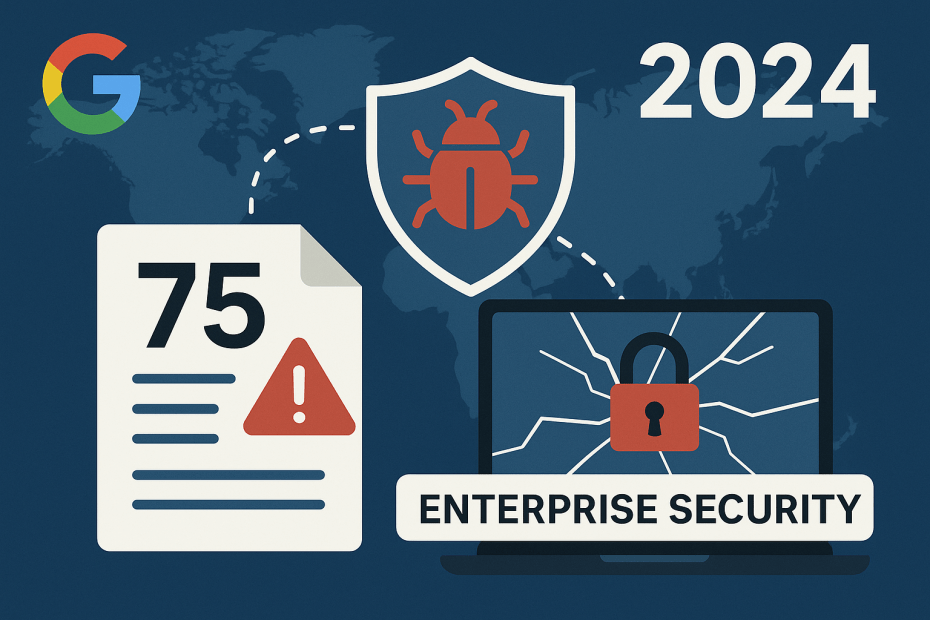Cybersecurity continues to be a battlefield where attackers relentlessly seek to exploit vulnerabilities for illicit gains. In its latest threat intelligence update, Google has revealed critical insights into zero-day vulnerabilities actively exploited in 2024. Significantly, 44% of these attacks focused on enterprise security products, highlighting the growing risk for businesses worldwide.
What Are Zero-Day Vulnerabilities?
Zero-day vulnerabilities are security flaws that are exploited by attackers before the software vendor or public become aware of them, leaving no time for defense or patches. These vulnerabilities pose serious risks as they allow attackers to bypass security measures and infiltrate systems undetected.
Google’s 2024 Zero-Day Exploitation Report: Key Highlights
Based on data collected and analyzed by the Google Threat Intelligence Group (GTIG), here are the critical findings:
- In total, 75 zero-day vulnerabilities were exploited in the wild in 2024, a decrease from 98 in 2023.
- Nearly 44% of these targeted enterprise software products, with many attacks focusing on security and network appliances.
- 20 vulnerabilities were found specifically in security software and appliances from vendors including Ivanti, Palo Alto Networks, and Cisco.
- Operating systems and browsers targeted include Microsoft Windows (22 vulnerabilities), Android (7 vulnerabilities), Apple’s iOS and Safari (2 and 3 respectively), Google Chrome (7), and Mozilla Firefox (1).
- Exploit chains—complex attacks leveraging multiple zero-day flaws—remain prevalent in targeting mobile devices, accounting for roughly 90% of mobile exploits.
- 18 unique enterprise vendors were targeted in 2024, with Microsoft leading at 26 zero-days, followed by Google (11), Ivanti (7), and Apple (5).
- Several zero-day exploits were attributed to threat actors linked to state-sponsored espionage and financially motivated groups from countries such as China, Russia, North Korea, and South Korea.
Why Enterprise Security Products Are High-Value Targets
Enterprise security and network tools are designed to protect large-scale systems and sensitive data, often possessing privileged access. This makes them highly attractive to attackers seeking comprehensive control over networks and access to critical infrastructure.
GTIG researchers emphasize that the increasing sophistication and prevalence of zero-day exploits against these products underscore the need for businesses to adopt more robust, proactive defense strategies.
Notable Zero-Day Exploit Chains Discovered
One example includes a malicious JavaScript injection found on the website of the Diplomatic Academy of Ukraine that exploited CVE-2024-44308, enabling arbitrary code execution. This flaw was chained with CVE-2024-44309 in WebKit to perform cross-site scripting attacks and unauthorized access to Microsoft’s login portal.
Additionally, Google identified an exploit chain targeting Firefox and Tor browsers using two zero-days (CVE-2024-9680 and CVE-2024-49039), allowing attackers to break out of the browser sandbox and execute malicious code. This attack facilitated the deployment of RomComRAT, linked to the threat group known as RomCom (aka CIGAR) known for combined financial and espionage motivations.
Trends and Future Outlook
While zero-day exploitation rates show a slight decrease compared to prior years, the threat landscape is evolving. Vendors are making strides in mitigating exploits on historically targeted products; however, attackers are shifting focus towards enterprise-grade solutions, which often involve a diverse vendor ecosystem.
Casey Charrier, Senior Analyst at GTIG, states, “The future of zero-day exploitation will ultimately depend on vendors’ ability and commitment to counter these threats with proactive security measures.”
What Small Business Should Take Away
Even if your organization is not a large enterprise, the targeting of widely used products makes it critical for all users to stay vigilant. Here are practical recommendations:
- Regularly update all software, especially security tools and operating systems, to benefit from the latest patches.
- Monitor vendor security advisories to quickly respond to emerging threats.
- Implement multi-layered security approaches, including firewalls, endpoint detection, and network monitoring.
- Consider professional cybersecurity services to perform vulnerability assessments and incident response planning.
For comprehensive cybersecurity solutions tailored to protect your business’s digital assets, explore the range of enterprise and small business security services designed to mitigate modern threats effectively.
Conclusion
Google’s 2024 report on exploited zero-day vulnerabilities reveals a shifting attack landscape where enterprise security products are increasingly at risk. Businesses of all sizes must prioritize vulnerability management and proactive defenses to safeguard their networks from sophisticated attackers leveraging zero-days. Staying informed and agile is the best way to defend against these complex threats in 2025 and beyond.
Stay updated with the latest cybersecurity news and expert insights by following trusted sources and subscribing to newsletters. Don’t wait – protect your digital infrastructure today.
